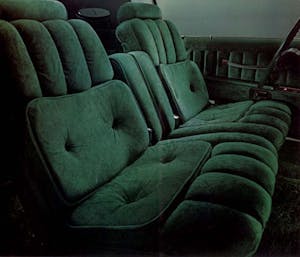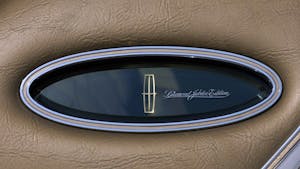Lincoln’s 1977–79 Continental Mark V is peak personal luxury for less than $20K
The personal luxury car forged a path to profitability via padded roofs, neoclassic opera windows, formal grilles, and needlessly ornate trim atop an otherwise pedestrian vehicle. These posh features weren’t unique to Detroit, however: Toyota Celicas sported plasti-chrome, faux-woodgrain interiors, the Mazda Cosmo (CD) had opera windows and extensive chrome plating. Meanwhile, Datsun stole the show with the most decadent TV commercial of the Malaise Era.
So what exactly distinguished Lincoln’s 1977–79 Continental Mark V? Its many elaborate, designer-label special editions crowned the Mark V king of ’70s personal luxury cars; today, you can snag a 1977–79 designer-bedecked edition for only slightly more than a standard model—which was no slouch in the luxury department itself.

Perhaps the Mark V’s nearly quarter-million sales in three years of production is a good starting point to demonstrate its clout in the luxury market. The flagship of Lincoln’s fleet, the 1977–79 Continental Mark V combined the 1961–69 Continental’s distraction-free body sides with its 1956–57 predecessor’s overindulgence in details. The result was a personal luxury coupe with unparalleled presence. Its blade-like overhangs, covered headlights, and ridiculous proportions took the Mark V to a place that the recently-downsized Coupe DeVille couldn’t touch, and the Lincoln handily outsold the significantly smaller, baroque Eldorado.
Standard features like shag carpeting, opera windows, power everything, automatic climate control, four-wheel disc brakes, four-speaker audio, and a Cartier Chronometer (don’t call it a clock!) ensured the Mark V had personal luxury in spades.

Notable options included a 7.5-liter V-8, three levels of seating decadence, Sure Track anti-lock brakes, a “Miles to Empty” fuel computer, cast or forged aluminum wheels, three vinyl top configurations, Quadrasonic tape deck, and even a garage-door opener mounted on the sun visor. A mind-numbing array of paint, wheel, and trim configurations were available—and that’s before you selected one of the curated “Luxury Group” color palettes, which were dictated by the exterior color you chose (e.g. Wedgewood Blue Luxury Group).
Ultra-low-mile, time-capsule cars have fared particularly well at auction in recent years; median #2 (Excellent) condition values are up 7 percent over the past three years, and median #1-condition (Concours) values have jumped nearly 21 percent. However, because of the rarity of zero-option examples, it’s hard to pinpoint the hottest-selling Mark V configurations. Most command a similar price, with #1- and #2-condition examples falling within $2000 of each other regardless of factory equipment.

These close price margins are especially ironic when you consider that not all Mark Vs were created equal. Far from it—this automotive canvas was a designer’s delight. Every year Ford paid the licensing fees for Bill Blass, Cartier, Hubert de Givenchy, and Emilio Pucci so they’d make their mark (sorry) on Lincoln’s flagship, affixing their respective brand names in gold on both opera windows. Pucci, Givenchy, and Cartier Edition cars are currently worth the most, but their #2-condition values are only about $1400 more than a base car’s. Adjusted for inflation, this is a relative bargain compared to the editions’ original prices; designer editions were $7000–$9000 more expensive on the showroom floor. Whether you opt for the designer label or no, buying a Mark V won’t drain your wallet. Excellent, #2-condition cars across all variants fall under $20,000, and if you’re willing to stoop to a driver-quality, #3 (Good) condition example, this slice of peerless Lincoln prestige can be yours for under $10,000.

The ultimate Mark V was either the 1978 Diamond Jubilee Edition (DJE) or its successor, the 1979 Collector’s Series (CE). Together with the DJE Thunderbird, the DJE Mark V comprised a pair of special editions celebrating Ford’s 75th Anniversary. The CE was the last hurrah before Lincoln downsized the Mark Series onto Ford’s ubiquitous Panther platform. Both the DJE and CE had leather-wrapped dashboards and consoles, velour wrapping every trim piece, color-matched shag carpeting in the trunk, leather-wrapped tool kit, jeweled hood ornament, and a padded Continental kit at the rear. CE models could be ordered in more colors and had a split bench seat option, but these rarities have yet to make a difference in transaction prices.
Lincoln

While the Collectors Edition didn’t have the Diamond Jubilee’s signature diamond opera windows, it’s hard to argue with Tom Selleck promoting such a finely appointed machine. The glitzy details weren’t cheap in the 1970s, though, costing buyers roughly 65 percent more than a regular Mark V. If the Continental Mark V is the Malaise-Era Mount Everest of personal luxury, the DJE and CE are at the summit.
Perhaps the market does indeed see the distinction: The highest-selling price we could find was a museum-quality DJE with only 56 miles, which sold last year for $49,500. Our transaction data shows most Mark Vs in similar condition would be closer to $36,000. There’s certainly room for growth, especially as buyers learn that Mark V designer editions and the DJE/CE weren’t just an emblem slapped on the roof.
Demographics skew disproportionately to older buyers, but 16 percent of online insurance quote activity comes from millennials, and a healthy 26 percent of online insurance quotes are from Gen Xers. With interest on both ends of the age spectrum, perhaps the Continental Mark V’s high-dollar, diamond-encrusted trim levels will catch the eye of a discerning contingent. For now, they’re certainly a steal.


